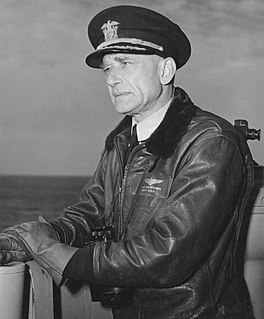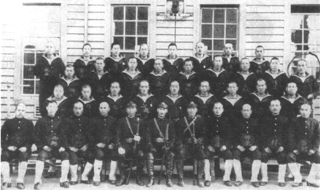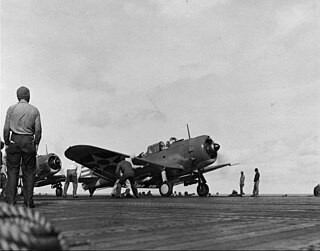
The Battle of the Coral Sea, from 4 to 8 May 1942, was a major naval battle between the Imperial Japanese Navy (IJN) and naval and air forces of the United States and Australia. Taking place in the Pacific Theatre of World War II, the battle is historically significant as the first action in which the opposing fleets neither sighted nor fired upon one another, attacking over the horizon with aircraft carriers instead.

Zuikaku was the second and last Shōkaku-class aircraft carrier built for the Imperial Japanese Navy (IJN) shortly before the beginning of the Pacific War. Her aircraft took part in the attack on Pearl Harbor that formally brought the United States into the war, and she fought in several of the most important naval battles of the war, before being sunk during the Battle of Leyte Gulf.

USS Enterprise (CV-6) was a Yorktown-class carrier built for the United States Navy during the 1930s. She was the seventh U.S. Navy vessel of that name. Colloquially called "The Big E", she was the sixth aircraft carrier of the United States Navy. Launched in 1936, she was one of only three American carriers commissioned before World War II to survive the war. She participated in more major actions of the war against Japan than any other United States ship. These actions included the attack on Pearl Harbor — 18 Douglas SBD Dauntless dive bombers of her air group arrived over the harbor during the attack; seven were shot down with eight airmen killed and two wounded, making her the only American aircraft carrier with men at Pearl Harbor during the attack and the first to sustain casualties during the Pacific War — the Battle of Midway, the Battle of the Eastern Solomons, the Battle of the Santa Cruz Islands, various other air-sea engagements during the Guadalcanal Campaign, the Battle of the Philippine Sea, and the Battle of Leyte Gulf. Enterprise earned 20 battle stars, the most for any U.S. warship in World War II, and was the most decorated U.S. ship of World War II. She was also the first American ship to sink a full-sized enemy warship after the Pacific War had been declared when her aircraft sank the Japanese submarine I-70 on 10 December 1941. On three occasions during the war, the Japanese announced that she had been sunk in battle, inspiring her nickname "The Grey Ghost". By the end of the war, her planes and guns had downed 911 enemy planes, sunk 71 ships, and damaged or destroyed 192 more.

Task Force 11 is a designation that has been used by the United States armed forces for two separate units.

Task Force 16 (TF16) was one of the most storied task forces in the United States Navy, a major participant in a number of the most important battles of the Pacific War.

Raymond Ames Spruance was a United States Navy admiral during World War II. He commanded U.S. naval forces during one of the most significant naval battles that took place in the Pacific Theatre: the Battle of the Philippine Sea. He also commanded Task Force 16 at the Battle of Midway, comprising the carriers Enterprise and Hornet. At Midway, dive bombers from the Enterprise crippled two carriers of the Imperial Japanese Navy, Kaga and the flagship Akagi. Most historians consider Midway the turning point of the Pacific War.

The naval Battle of the Eastern Solomons took place on 24–25 August 1942, and was the third carrier battle of the Pacific campaign of World War II and the second major engagement fought between the United States Navy and the Imperial Japanese Navy during the Guadalcanal campaign. As at the Battle of the Coral Sea and the Battle of Midway, the ships of the two adversaries were never within sight of each other. Instead, all attacks were carried out by carrier-based or land-based aircraft.

The Yorktown class was a class of three aircraft carriers built for the United States Navy and completed shortly before World War II, the Yorktown (CV-5), Enterprise (CV-6), and Hornet (CV-8). They immediately followed Ranger, the first U.S. aircraft carrier built as such, and benefited in design from experience with Ranger and the earlier Lexington class, which were conversions into carriers of two battlecruisers that were to be scrapped to comply with the Washington Naval Treaty, an arms limitation accord.

The Battle of the Santa Cruz Islands, fought during 25–27 October 1942, sometimes referred to as the Battle of Santa Cruz or Third Battle of Solomon Sea, in Japan as the Battle of the South Pacific, was the fourth aircraft carrier battle of the Pacific campaign of World War II. It was also the fourth major naval engagement fought between the United States Navy and the Imperial Japanese Navy during the lengthy and strategically important Guadalcanal campaign. As in the battles of the Coral Sea, Midway, and the Eastern Solomons, the ships of the two adversaries were rarely in sight or gun range of each other. Instead, almost all attacks by both sides were mounted by carrier- or land-based aircraft.

USS Portland (CL/CA–33) was the lead ship of the Portland class of cruiser and the first ship of the United States Navy named after the city of Portland, Maine. Launched in 1932, she completed a number of training and goodwill cruises in the interwar period before seeing extensive service during World War II, beginning with the Battle of the Coral Sea in 1942, where she escorted the aircraft carrier Yorktown and picked up survivors from the sunken carrier Lexington. She screened for Yorktown again in the Battle of Midway, picking up her survivors as well. She then supported the carrier Enterprise during the initial phase of the Guadalcanal Campaign later that year, and was torpedoed during the Naval Battle of Guadalcanal. The torpedo inflicted heavy damage which put her out of action for six months as she was repaired in Sydney, Australia, and later San Diego, California.
This is a list of aviation-related events from 1942:

Frank Jack Fletcher was an admiral in the United States Navy during World War II. Fletcher commanded five different task forces through WWII; he was the operational task force commander at the pivotal battles of the Coral Sea and Midway, which collectively resulted in the sinking of six Japanese fleet carriers.

Thomas Cassin Kinkaid was an admiral in the United States Navy, known for his service during World War II. He built a reputation as a "fighting admiral" in the aircraft carrier battles of 1942 and commanded the Allied forces in the Aleutian Islands Campaign. He was Commander Allied Naval Forces and the Seventh Fleet under General of the Army Douglas MacArthur in the Southwest Pacific Area, where he conducted numerous amphibious operations, and commanded an Allied fleet during the Battle of Leyte Gulf, the largest naval battle of World War II and the last naval battle between battleships in history.

USS Monssen (DD-436), a Gleaves-class destroyer, was the first ship of the United States Navy to be named for Mons Monssen, who was awarded the Medal of Honor for his actions aboard USS Missouri (BB-11) in 1904. Commissioned in 1941, the destroyer saw service during World War II in both Atlantic and Pacific Oceans. Monssen was sunk at the Naval Battle of Guadalcanal on 13 November 1942.

Miles Rutherford Browning was an officer in the United States Navy in the Atlantic during World War I and in the Pacific during World War II. A pioneer in the development of aircraft carrier combat operations concepts, he is noted for his aggressive aerial warfare tactics as a captain on the USS Enterprise during World War II. His citation for the Distinguished Service Medal states: "His judicious planning and brilliant execution was largely responsible for the rout of the enemy Japanese fleet in the Battle of Midway." Craig Symonds disagreed, writing that “the citation claim[ing] that Browning was ‘largely responsible’ for the American victory at Midway, an assertion that some historians have taken seriously. .. is manifestly untrue.”

The invasion of Tulagi, on 3–4 May 1942, was part of Operation Mo, the Empire of Japan's strategy in the South Pacific and South West Pacific Area in 1942. The plan called for Imperial Japanese Navy troops to capture Tulagi and nearby islands in the British Solomon Islands Protectorate. The occupation of Tulagi by the Japanese was intended to cover the flank of and provide reconnaissance support for Japanese forces that were advancing on Port Moresby in New Guinea, provide greater defensive depth for the major Japanese base at Rabaul, and serve as a base for Japanese forces to threaten and interdict the supply and communication routes between the United States and Australia and New Zealand.

Operation RY was the Imperial Japanese plan to invade and occupy Nauru and Ocean islands in the south Pacific during the Pacific conflict of World War II. The operation was originally set to be executed in May 1942 immediately following Operation MO and before Operation MI, which resulted in the Battle of Midway. The primary reason for the operation was to exploit the islands' supplies of phosphate. After a postponement due to interference by enemy forces, the operation was completed in August 1942.

The Marshalls–Gilberts raids were tactical airstrikes and naval artillery attacks by United States Navy aircraft carrier and other warship forces against Imperial Japanese Navy (IJN) garrisons in the Marshall and Gilbert Islands on 1 February 1942.

Ayao Shirane was a fighter ace in the Imperial Japanese Navy (IJN) during World War II. He participated in various battles and campaigns throughout the Pacific War and was eventually shot down and killed over Leyte, Philippines on 24 November 1944. He was officially credited with destroying nine enemy aircraft.
Paul Hubert Ramsey was a World War II naval aviator of the United States Navy (USN).

















